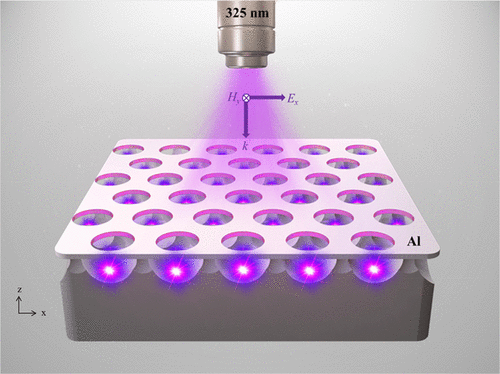当前位置:
X-MOL 学术
›
J. Phys. Chem. C
›
论文详情
Our official English website, www.x-mol.net, welcomes your
feedback! (Note: you will need to create a separate account there.)
Light-Trapped Nanocavities for Ultraviolet Surface-Enhanced Raman Scattering
The Journal of Physical Chemistry C ( IF 3.3 ) Pub Date : 2021-07-28 , DOI: 10.1021/acs.jpcc.1c05175 Yue Zeng 1 , Renxian Gao 1 , Jingyu Wang 1 , Tien-Mo Shih 2 , Guoya Sun 1 , Jiasheng Lin 3 , Yonglin He 1 , Jiawei Chen 3 , Da Zhan 4 , Jinfeng Zhu 5 , Weimin Yang 1 , Peiwen Ren 1 , Fangfei Jiao 1 , Zhilin Yang 1
The Journal of Physical Chemistry C ( IF 3.3 ) Pub Date : 2021-07-28 , DOI: 10.1021/acs.jpcc.1c05175 Yue Zeng 1 , Renxian Gao 1 , Jingyu Wang 1 , Tien-Mo Shih 2 , Guoya Sun 1 , Jiasheng Lin 3 , Yonglin He 1 , Jiawei Chen 3 , Da Zhan 4 , Jinfeng Zhu 5 , Weimin Yang 1 , Peiwen Ren 1 , Fangfei Jiao 1 , Zhilin Yang 1
Affiliation

|
The fabrication of surface-enhanced Raman scattering (SERS) substrates with large areas, high activities, desirable uniformities, and aggregated hot spots evenly distributed in the UV (ultraviolet) region has been regarded as a formidable task. In the present work, by means of elaborate structure designs and material selections, we have fabricated periodic light-trapped nanocavities that have overcome the abovementioned difficulties. Specifically, a great amount of electromagnetic energy has been localized in nanocavities due to repeated reflections of the trapped incident light, thus re-amplifying abundant hot spots of the aluminum film. At an excitation wavelength of 325 nm, the acquisition of ultrahigh SERS enhancement factors (≳106) has been successfully achieved, and signal intensities are uniformly distributed after repeated measurements. In the originally weak UV region, our nanostructure design and its associated mechanism may provide a guide for future SERS-related research.
中文翻译:

用于紫外表面增强拉曼散射的光捕获纳米腔
制造具有大面积、高活性、理想的均匀性和均匀分布在 UV(紫外线)区域的聚集热点的表面增强拉曼散射 (SERS) 基板被认为是一项艰巨的任务。在目前的工作中,通过精心的结构设计和材料选择,我们制造了克服上述困难的周期性光捕获纳米腔。具体而言,由于捕获的入射光的反复反射,大量的电磁能量被局限在纳米腔中,从而重新放大了铝膜的大量热点。在 325 nm 激发波长下,获得超高 SERS 增强因子 (≳10 6) 已成功实现,并且经过重复测量后信号强度分布均匀。在最初的弱紫外线区域,我们的纳米结构设计及其相关机制可能为未来的 SERS 相关研究提供指导。
更新日期:2021-08-12
中文翻译:

用于紫外表面增强拉曼散射的光捕获纳米腔
制造具有大面积、高活性、理想的均匀性和均匀分布在 UV(紫外线)区域的聚集热点的表面增强拉曼散射 (SERS) 基板被认为是一项艰巨的任务。在目前的工作中,通过精心的结构设计和材料选择,我们制造了克服上述困难的周期性光捕获纳米腔。具体而言,由于捕获的入射光的反复反射,大量的电磁能量被局限在纳米腔中,从而重新放大了铝膜的大量热点。在 325 nm 激发波长下,获得超高 SERS 增强因子 (≳10 6) 已成功实现,并且经过重复测量后信号强度分布均匀。在最初的弱紫外线区域,我们的纳米结构设计及其相关机制可能为未来的 SERS 相关研究提供指导。











































 京公网安备 11010802027423号
京公网安备 11010802027423号